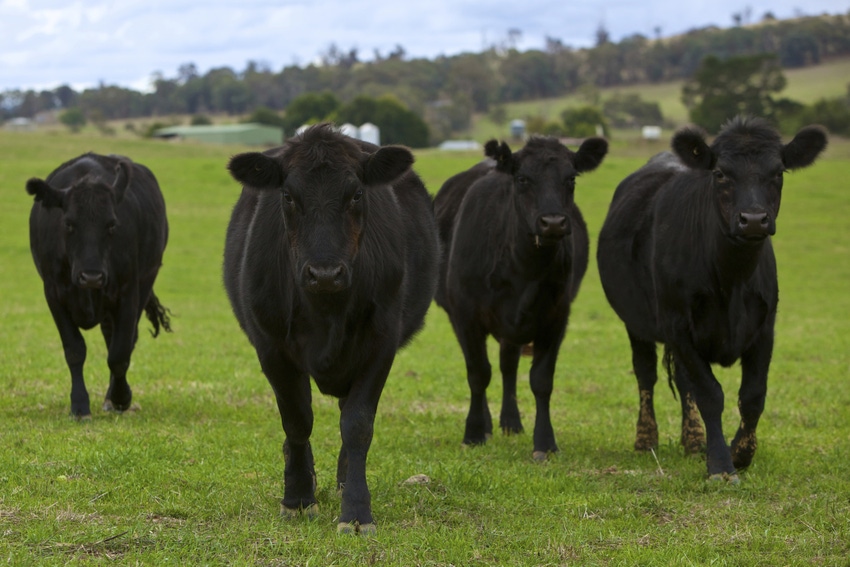Nutritionist discusses pros and cons of supplementing cattle with distillers grains in winter feeding programs.
October 26, 2018

With winter just around the corner, Hubbard Feeds beef nutritionist Dr. Cadra Van Bibber-Krueger said it is once again time to start thinking about protein and energy supplementation for cattle.
In a Hubbard Feeds "Beef Solutions" blog, she said there are many advantages to supplementing a winter feeding program with distillers grains or products made with distillers grains. However, there are also some disadvantages that need to be considered before feeding decisions are made.
Advantages
Corn used for ethanol production goes through a process of fermentation in which the starch is removed from the grain. Remaining nutrients, such as protein and fat, are concentrated to approximately three times the level found in the corn grain itself, Van Bibber-Krueger said. Distillers grain contains between 25% and 35% crude protein, making it a good winter feeding source of this critical nutrient, she added.
Distillers grains are typically included in the diets as a source of protein, yet it has an energy value equal to or greater than corn. With the removal of starch from the grain, the energy comes from corn oil and digestible fiber as well as some from crude protein, she explained. Because the energy in distillers grains comes primarily from digestible fiber rather than starch, it is less likely to upset the rumen and create acidosis compared to corn, Van Bibber-Krueger said.
Distillers grains are also a good source of phosphorus and can reduce or eliminate the need for phosphorus supplementation, she added, noting that it is still important for producers to have balanced mineral programs in place to maintain a minimum calcium-to-phosphorus ratio of 2:1.
Disadvantages
According to Van Bibber-Krueger, the nutrient composition of distillers grains can be variable due to differences in the processes within ethanol plants over time as well as differences in production among ethanol plants. In addition, solubles are added back to distillers grains in differing proportions, which further increases nutrient variability.
Sulfur levels in distillers grains range from 0.35% to 1.40%, which can potentially cause health concerns in beef cattle, she said. Cattle have a nutrient requirement for sulfur of 0.15% of dry matter, with a maximum tolerable threshold of 0.4%, she said. Clinical signs of sulfur toxicity include decreased feed intake and slow or stunted growth, and sulfur toxicity can also contribute to the incidence of polioencephalomalacia. In addition, high sulfur concentrations can lead to decreased copper absorption and the potential for copper deficiency, if proper mineral supplementation is not available, Van Bibber-Krueger noted.
She said it is extremely important for cattle producers to consider all of the sulfur sources that will be consumed by cattle before deciding to include distillers grains or related products in their winter feeding programs. Sources containing sulfur include all feedstuffs, supplements and water. Water sulfate levels of 1,000 parts per million or less are considered safe and may be a diminished cause of concern when feeding distillers grains. Still, water sulfate levels reach 3,000 ppm or higher on many western ranches, Van Bibber-Krueger explained. In high-sulfate areas, distillers grains should either be fed with extreme caution or not at all, she said.
It is very important to take samples of water, distillers grains or related products and all feedstuffs to ensure cattle health. In areas where sulfate levels can be high, distillers grains should be routinely tested to ensure that total dietary sulfur remains below 0.4% of the dry matter and water source combined, she emphasized.
Van Bibber-Krueger noted that ranches with high molybdenum levels in forages may also pose a risk to cattle health when distillers grains are fed. In addition to the high sulfur levels often found in distillers grains, high molybdenum levels in forages can also bind copper and prevent absorption, posing an even higher risk of copper deficiency when combined with feeding distillers grains, she explained.
Summary
Van Bibber-Krueger concluded that distillers grains and related products can provide a good source of protein, energy and phosphorus to cattle during the winter months, but producers should collect information about winter pastures before making the decision to include distillers grains in cattle diets, including such data as sulfate levels in both their water supply and forages and the molybdenum levels in forages.
You May Also Like



